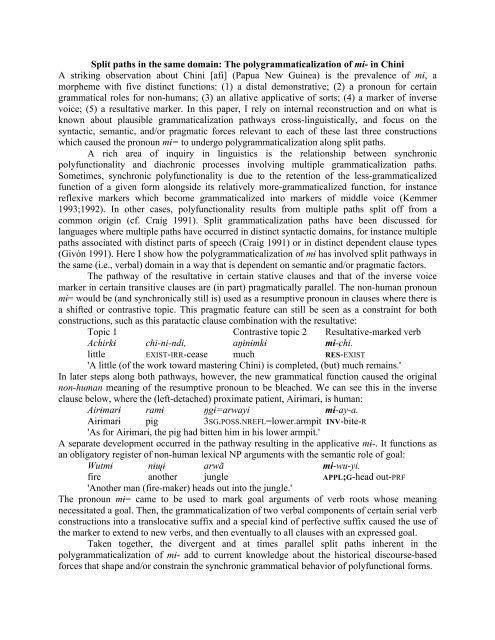lit paths in - Linguistics
lit paths in - Linguistics
lit paths in - Linguistics
Create successful ePaper yourself
Turn your PDF publications into a flip-book with our unique Google optimized e-Paper software.
Sp<strong>lit</strong> <strong>paths</strong> <strong>in</strong> the same doma<strong>in</strong>: The polygrammaticalization of mɨ- <strong>in</strong> Ch<strong>in</strong>i<br />
A strik<strong>in</strong>g observation about Ch<strong>in</strong>i [afi] (Papua New Gu<strong>in</strong>ea) is the prevalence of mɨ, a<br />
morpheme with five dist<strong>in</strong>ct functions: (1) a distal demonstrative; (2) a pronoun for certa<strong>in</strong><br />
grammatical roles for non-humans; (3) an allative applicative of sorts; (4) a marker of <strong>in</strong>verse<br />
voice; (5) a resultative marker. In this paper, I rely on <strong>in</strong>ternal reconstruction and on what is<br />
known about plausible grammaticalization pathways cross-l<strong>in</strong>guistically, and focus on the<br />
syntactic, semantic, and/or pragmatic forces relevant to each of these last three constructions<br />
which caused the pronoun mɨ= to undergo polygrammaticalization along sp<strong>lit</strong> <strong>paths</strong>.<br />
A rich area of <strong>in</strong>quiry <strong>in</strong> l<strong>in</strong>guistics is the relationship between synchronic<br />
polyfunctiona<strong>lit</strong>y and diachronic processes <strong>in</strong>volv<strong>in</strong>g multiple grammaticalization <strong>paths</strong>.<br />
Sometimes, synchronic polyfunctiona<strong>lit</strong>y is due to the retention of the less-grammaticalized<br />
function of a given form alongside its relatively more-grammaticalized function, for <strong>in</strong>stance<br />
reflexive markers which become grammaticalized <strong>in</strong>to markers of middle voice (Kemmer<br />
1993;1992). In other cases, polyfunctiona<strong>lit</strong>y results from multiple <strong>paths</strong> sp<strong>lit</strong> off from a<br />
common orig<strong>in</strong> (cf. Craig 1991). Sp<strong>lit</strong> grammaticalization <strong>paths</strong> have been discussed for<br />
languages where multiple <strong>paths</strong> have occurred <strong>in</strong> dist<strong>in</strong>ct syntactic doma<strong>in</strong>s, for <strong>in</strong>stance multiple<br />
<strong>paths</strong> associated with dist<strong>in</strong>ct parts of speech (Craig 1991) or <strong>in</strong> dist<strong>in</strong>ct dependent clause types<br />
(Givón 1991). Here I show how the polygrammaticalization of mɨ has <strong>in</strong>volved sp<strong>lit</strong> pathways <strong>in</strong><br />
the same (i.e., verbal) doma<strong>in</strong> <strong>in</strong> a way that is dependent on semantic and/or pragmatic factors.<br />
The pathway of the resultative <strong>in</strong> certa<strong>in</strong> stative clauses and that of the <strong>in</strong>verse voice<br />
marker <strong>in</strong> certa<strong>in</strong> transitive clauses are (<strong>in</strong> part) pragmatically parallel. The non-human pronoun<br />
mɨ= would be (and synchronically still is) used as a resumptive pronoun <strong>in</strong> clauses where there is<br />
a shifted or contrastive topic. This pragmatic feature can still be seen as a constra<strong>in</strong>t for both<br />
constructions, such as this paratactic clause comb<strong>in</strong>ation with the resultative:<br />
Topic 1 Contrastive topic 2 Resultative-marked verb<br />
Achirkɨ chi-ni-ndi, aŋɨnɨmkɨ mɨ-chi.<br />
<strong>lit</strong>tle EXIST-IRR-cease much RES-EXIST<br />
'A <strong>lit</strong>tle (of the work toward master<strong>in</strong>g Ch<strong>in</strong>i) is completed, (but) much rema<strong>in</strong>s.'<br />
In later steps along both pathways, however, the new grammatical function caused the orig<strong>in</strong>al<br />
non-human mean<strong>in</strong>g of the resumptive pronoun to be bleached. We can see this <strong>in</strong> the <strong>in</strong>verse<br />
clause below, where the (left-detached) proximate patient, Airɨmarɨ, is human:<br />
Airɨmarɨ ramɨ ŋgɨ=arwayi mɨ-ay-a.<br />
Airɨmarɨ pig 3SG.POSS.NREFL=lower.armpit INV-bite-R<br />
'As for Airɨmarɨ, the pig had bitten him <strong>in</strong> his lower armpit.'<br />
A separate development occurred <strong>in</strong> the pathway result<strong>in</strong>g <strong>in</strong> the applicative mɨ-. It functions as<br />
an obligatory register of non-human lexical NP arguments with the semantic role of goal:<br />
Wutmɨ nɨɰɨ arwã mɨ-wu-yi.<br />
fire another jungle APPL;G-head out-PRF<br />
'Another man (fire-maker) heads out <strong>in</strong>to the jungle.'<br />
The pronoun mɨ= came to be used to mark goal arguments of verb roots whose mean<strong>in</strong>g<br />
necessitated a goal. Then, the grammaticalization of two verbal components of certa<strong>in</strong> serial verb<br />
constructions <strong>in</strong>to a translocative suffix and a special k<strong>in</strong>d of perfective suffix caused the use of<br />
the marker to extend to new verbs, and then eventually to all clauses with an expressed goal.<br />
Taken together, the divergent and at times parallel sp<strong>lit</strong> <strong>paths</strong> <strong>in</strong>herent <strong>in</strong> the<br />
polygrammaticalization of mɨ- add to current knowledge about the historical discourse-based<br />
forces that shape and/or constra<strong>in</strong> the synchronic grammatical behavior of polyfunctional forms.
References<br />
Craig, Colette. 1991. Ways to go <strong>in</strong> Rama: a case study <strong>in</strong> polygrammaticalization. In<br />
Traugott and He<strong>in</strong>e (eds.), vol. 2: 455-92.<br />
Givón, Talmy. 1991. The evolution of dependent clause morphosyntax <strong>in</strong> Biblical<br />
Hebrew. In Traugott and He<strong>in</strong>e (eds.), vol. 2: 257-310.<br />
Kemmer, Suzanne. 1993. The Middle Voice. Amsterdam: Benjam<strong>in</strong>s. Typological Studies<br />
<strong>in</strong> Language 23.<br />
Kemmer, Suzanne. 1992. Grammatical prototypes and compet<strong>in</strong>g motivations <strong>in</strong> a theory of<br />
l<strong>in</strong>guistic change. In Garry Davis and Gregory Iverson (eds.), Explanation <strong>in</strong> Historical<br />
L<strong>in</strong>guistics. Current Issues <strong>in</strong> L<strong>in</strong>guistic Theory 84: 145-66. Amsterdam: Benjam<strong>in</strong>s.<br />
Gloss<strong>in</strong>g conventions<br />
APPL;G Allative applicative (for goal arguments)<br />
EXIST Existential<br />
INV Inverse voice<br />
IRR Irrealis<br />
PL<br />
Plural<br />
POSS.NREFL Non-reflexive possessive<br />
PRF Perfect aspect<br />
R<br />
Realis<br />
RES Resultative<br />
SG S<strong>in</strong>gular
















